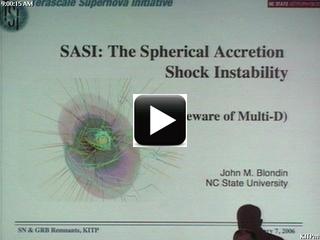The origin of asymmetry in core-collapse supernovae may arise in the first
few hundred milliseconds after bounce when the nascent shockwave is susceptible to the spherical accretion shock instability. We
provide quantitative measurement of the growth of both an axisymmetric mode
(l=1) and a non-axisymmetric mode (m=1) in the linear regime, and argue
that this instability is a growing pressure wave driven by the dynamic
response of the accretion shock. Recent 3D simulations haveshown that the non-axisymmetric mode of the SASI dominates the nonlinear
evolution, and can impart a significant amount of angular momentum to the
underlying neutron star.
 Other video options
Other video options
To begin viewing slides, click on the first slide below. (Or, view as pdf.)
![[01]](tn/01.jpg)
![[02]](tn/02.gif)
![[03]](tn/03.jpg)
![[04]](tn/04.jpg)
![[05]](tn/05.gif)
![[06]](tn/06.gif)
![[07]](tn/07.jpg)
![[08]](tn/08.gif)
![[09]](tn/09.gif)
![[10]](tn/10.gif)
![[11]](tn/11.jpg)
![[12]](tn/12.jpg)
![[13]](tn/13.jpg)
![[14]](tn/14.jpg)
![[15]](tn/15.jpg)
![[16]](tn/16.gif)
![[17]](tn/17.gif)
![[18]](tn/18.jpg)
![[19]](tn/19.jpg)
![[20]](tn/20.jpg)
![[21]](tn/21.jpg)
![[22]](tn/22.jpg)
![[23]](tn/23.gif)
![[24]](tn/24.jpg)
![[25]](tn/25.jpg)
![[26]](tn/26.jpg)
![[27]](tn/27.gif)
![[28]](tn/28.jpg)
![[29]](tn/29.gif)
![[30]](tn/30.gif)
![[31]](tn/31.gif)
![[32]](tn/32.jpg)
![[33]](tn/33.jpg)
![[34]](tn/34.jpg)